Icon Audio ST40 MkIIIm
The ‘m’ variant of the long-running
IconAudio Stereo 40 series has a small front panel meter so that the user can
easily check and adjust the bias applied to its four KT88 output valve. This
can also be used to show the output level averaging the two voltages at the
8ohm speaker terminals which is arguably less useful. Since the switchable
negative feedback is also taken from this point, these are the outputs used for
my listening tests, with the sensitivity set to low.
The Stereo 40 is very well specified with
three line-inputs plus a proper tape loop, a remote volume control, a low power
‘standby’ mode and a switch for triode or ultra-linear configuration of the
KT88s. I used the latter which offers roughly double the output power with
little change to the sound quality.
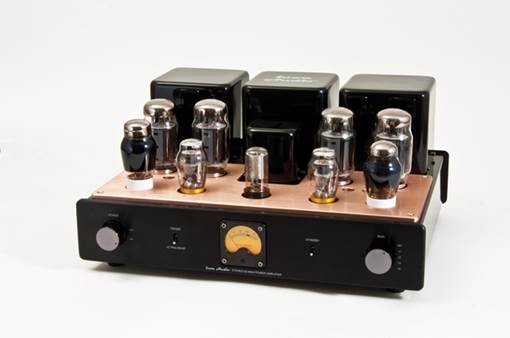
Icon’s
‘m’ series is distinguished by its combined bias adjust/ power meter. Our
sample was fitted with KT88s
An interesting technical point is that the
6SL7 input stage and the two 6SN7 drivers are powered by a big 274B rectifier
in the center. In common with most modern amplifiers the output stages still
have their needs met by conventional silicon diodes, however. In common with
the Ming Da MC368-BSE, point-to-point wiring is used throughout.
Power for pop
In my setup, the response yielded by the
Stereo 40 seemed to be a bit ‘up and down’ with the Level 42 track, bass was
heavy and vocals vivid but the lower midrange sounded slightly ‘sucked out’, as
did the extreme treble. In practice, this turns out to be a fair balance for
much rock and pop music where the Stereo 40 comes across as a strong and lively
performer able to make good use of the available power. Its mains transformer
does get rather hot after a few hours of use, however. Stereo imaging and sound
staging was similar to that offered by the Pathos, centered about each speaker.
A presence lift raised Katie Melua well
clear of her backing group even if her voice wasn’t quite as silky sounding as
with the Mystère. But if you prefer your music with a crisper edge then this
may well be more to your taste. And even if Mahler’s strings could not match
the drama of Melua’s vocals – they could seem slightly lost – the sound was
always smooth and detailed.
Sound quality: 80%
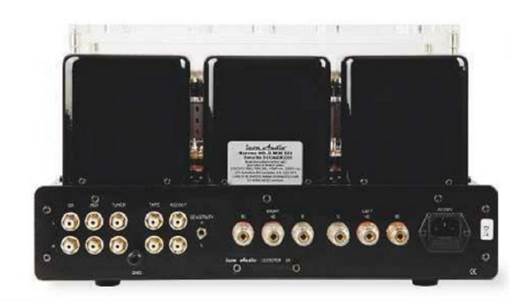
Three
line level inputs and a tape loop, plus outputs for 4 or 8ohm loudspeakers. The
small switch near the center sets the overall gain to either high or low by
altering the feedback
Lab report
Evidently, while Icon Audio was
retrofitting its ST40 mkIII amplifier with an integral bias meter, numerous
other ‘tweaks’ were implemented. This new version is actually very slightly
less powerful than its forebear, its power output almost precisely matching its
40W specification into 8 and 4ohm loads under both continuous and dynamic
conditions up to 2% THD (the ST40 mkIII offered a little closer to 45W). More
importantly, the amplifier’s response has been ‘flattened’, up from -2dB/20kHz
to -1.1dB/20kHz into 8ohm, and hugely extended into the sub-bass from
-1.7dB/5Hz to +0.25dB/5Hz here. Its performance into variable loudspeaker loads
also benefits from a reduced output impedance of just 0.75ohm – a worthwhile
drop from the ST40 mkIII’s 3ohm. Another indication that the ST40 mkIIIm’s
feedback has been tweaked is suggested by the reduced 0.35-0.75% distortion
(20Hz-20kHz, 10W) and the substantially improved 94.4dB A-wtd S/N ratio (re.
0dBW). Stereo separation is also boosted by a good 20dB over the older model.
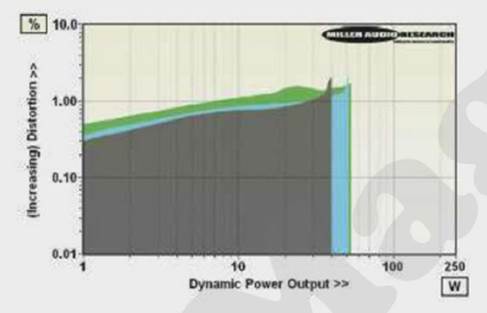
Dynamic
power output versus distortion into 8ohm (black trace), 4ohm (red), 2ohm (blue)
and 1ohm loads (green)
Specifications
·
Power output (<2% THD, 8/4ohm): 40W / 40W
·
Dynamic power (<2% THD, 8/4/2/1ohm): 40W /
40W / 51W / 54W
·
Output impedance (20Hz-20kHz): 0.75-1.05ohm
·
Frequency response (20Hz-20kHz):-0.1dB to -1.1dB
·
Input sensitivity (for 0dBW/40W): 155mV / 1080mV
(Low sens mode)
·
Wtd S/N ratio (re. 0dBW/40W): 94.4dB / 110.5dB
·
Distortion (20Hz-20kHz, 10W/8ohm): 0.35-0.75%
·
Power consumption (Idle/Rated o/p): 222W / 320W
·
Dimensions (WHD): 390x210x410mm
Ming Da MC368-BSE
Ming Da is one of the most famous Chinese
hi-fi brands and its range of valve amplifiers now includes a wide choice of
models. The MC368-BSE seen here uses KT90 output valves, a recently developed
beam Tetrode which, in this application, gives a claimed 70W/channel when used
in ultra-linear mode (a lower power triode mode is also available).
The circuit uses fixed bias but as this is
only adjustable using unlabeled internal controls the task is best left to a
dealer; the two meters just show the output voltage at the 8ohm loudspeaker
sockets. This is also the feedback reference point so I chose to connect the
loudspeakers here for my tests.
Four line-inputs are provided and the
volume control is motorized for remote operation via a simple handset. The
amplifier, which is nicely finished in satin black, has been assembled using
neat point to point wiring, the bulbous 6SN7 driver valves are famously
microponic, so the amplifier should be placed on a stable surface well away
from the loudspeakers. Tube rollers may well consider trying out different 6S7s
in pretty short order, as the rest of the design clearly warrants the
improvement.

An
awful lot of tube amp for the money – Ming Da couples four KT90 beam pentodes
with ‘onion bulb’ 6SN7 triodes as driver and phase-splitter
Even presentation
It comes as no surprise that the MC368-BSE
has a big, confident sound. The level 42 track was driven along with plenty of
gusto and even though the high volume levels that could be achieved were
similar to those available from the Icon, the bass seemed to stay tighter for a
greater part of the available range.
Comparisons with the Icon Audio Stereo 40
were interesting: the two units share the common trait of a clean, slightly dry
mid band and a noticeable bass lift, but the costlier Ming Da sounded more even
in its overall tonality. Despite being (in valve terms at least) a ‘muscle
amp’, the MC368-BSE rendered Katie Melua’s voice as rich and seductive, set
against a colorful landscape of backing instruments. Vocal clarity was excellent,
helped in no small part by an absence of grain or harshness in the upper
registers.
The Mahler showed a similar spatial
character to the Icon and the Pathos amps, although the central part of the
image was notably stronger and easier to tune-in to.
Sound quality: 8/10
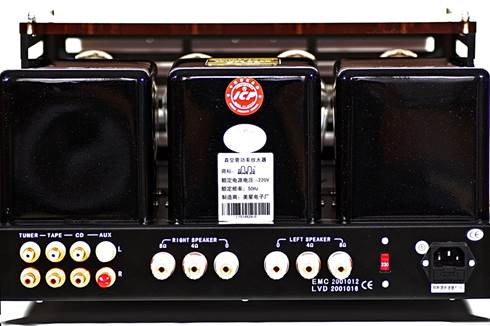
Four
line-level inputs are offered alongside 8/4ohm loudspeaker taps on 4mm binding
posts. Ming Da’s Tride/ Ultralinear mode switch is on the side
Lab report
Tested in ultra-linear mode, the pairs of
KT90 beam pentodes struggled to meet Ming Da’s rated 70W output under
continuous condition, achieving 2x15W/8ohm at 1%THD to 2x50W/8ohm at 3% THD.
Under dynamic, music-like, conditions the MC368-BSE did shine a little
brighter, achieving 30W/8ohm at 1% THD and 86W/8ohm (though the 8ohm tap) and
84W/4ohm (through the 4ohm tap) at 3% THD. At 10W/8ohm, distortion varies from
~0.5% through the midrange to 1.5% at low bass frequencies (20Hz) and 2% at
high treble frequencies (20kHz) but it’s the 4-6ohm output impedance that’ll
exert the biggest impact in tonal response depending on the impedance trend of
the attached loudspeaker. Into flat 8/4ohm loads via its 8/4ohm taps, the
response shows good bass extension (-0.25dB/20Hz and -3dB/3Hz) while the high
treble rolls gently away (-0.5dB/20kHz). The A-wtd S/N ratio was pooper on the
(weaker) right channel of our sample at 77.5dB but good at 84.5dB via the left
(re. 0dBW). PM
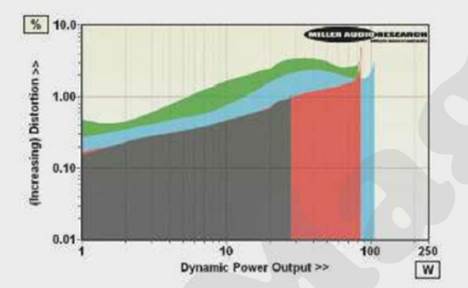
Dynamic
power output versus distortion into 8ohm (black trace), 4ohm (red), 2ohm (blue)
and 1ohm loads (green)
Specifications
·
Power output (<3% THD, 8/4ohm): 50W / 50W
·
Dynamic power (<3% THD, 8/4/2/1ohm): 86W /
84W / 105W / 82W
·
Output impedance (20Hz-20kHz): 3.9-6.0ohm
·
Frequency response (20Hz-20kHz):-0.25 to -0.50dB
·
Input sensitivity (for 0dBW/50W): 30mV / 220mV
·
Wtd S/N ratio (re. 0dBW/50W): 84.5dB / 101.5dB
·
Distortion (20Hz-20kHz, 1W/8ohm): 0.52-2.4%
·
Power consumption (Idle/Rated o/p): 173/300W
·
Dimensions (WHD): 550x480x380mm